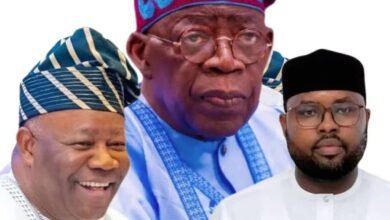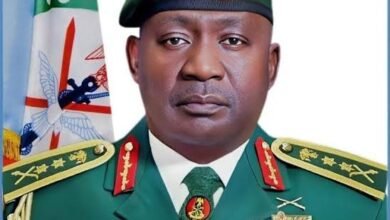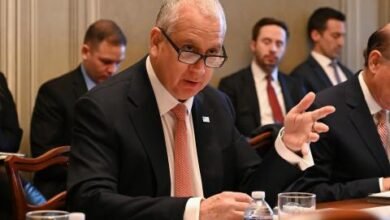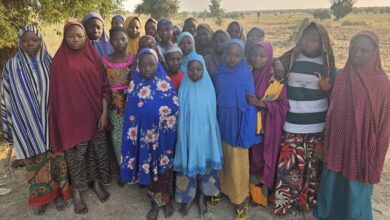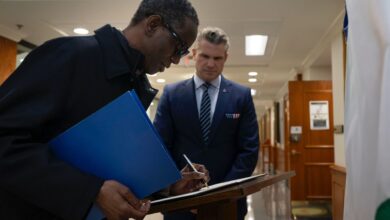
At exactly 2:57am on Wednesday, April 2nd, an announcement from the State House was released stating that President Bola Tinubu had approved the dissolution of the Nigeria National Petroleum Company (NNPC) and sacked its Group Chief Executive Officer, Mele Kyari, and Board Chairman, Pius Akinyelure.
The president cited the need for drastic change to drive economic growth, the boosting of investor confidence, and implementing diversification and commercialization in the gas sector.
It appears that the President was not getting these from the Mele Kyari led NNPC. But the question is what did he do while in office?
Mele Kyari was appointed as the Group Managing Director (GMD) of the Nigerian National Petroleum Corporation (NNPC) on June 20, 2019, officially assuming the role in July 2019. He served in this capacity until April 2, 2025.
Despite his unexpected removal, there is no denying that Mele Kyari made tremendous impact on the country’s petroleum sector. His tenure marked both highs and lows that defined the country’s oil and gas sector.
Here are some significant events that marked the 5-years and 9-months reign of the exited Group Chief Executive of NNPCL:
1. Incorporation of NNPC Limited under CAMA
Following the PIA’s enactment–which is arguably one of the biggest events that took place during Mr Mele Kyari’s time in office–the, NNPC was incorporated as a limited liability company under the Companies and Allied Matters Act (CAMA), enhancing its operational autonomy and efficiency. Its incorporation means that the NNPC will be commercially oriented and independent of the government, which means it will face annual auditing. This transition means it will maximize returns on investment, and the government will not subsidize the NNPC’s operations because, as a CAMA Company, it would be expected to pay dividends to shareholders, which in this case is the government. With the transition, the NNPC is also expected to enter new investments and partnerships in upstream assets to increase gas production in line with the decade of gas agenda.
2. The Rebranding of NNPC
In an attempt to present a new brand identity, NNPC unveiled a new logo during the occasion of its name change from NNPC to NNPC Limited on Tuesday 19th July 2022. This signified its transition from a government-run corporation to a commercial enterprise under the Petroleum Industry Act of 2021(PIA). The rebranding ceremony took place at the State House and the new logo was unveiled by former President Muhammadu Buhari. It did not take too long before the NNPC had put up its new logo in all its filling stations and digital media platforms. But did the rebranding of the country’s petroleum company make any significant changes to its years of opaqueness and lack of accountability?
3. Rehabilitation of Refineries
The NNPCL owns four refineries: two in Port Harcourt, one in Kaduna and another in Warri. Despite these refineries, the country, prior to the Dangote refinery coming on board imported all its fuel needs. Government after government made promises to rehabilitate the refineries and commence the refining of fuel and other petrochemicals, none ever succeeded. Through the years, the petroleum sector was awarded $3 billion for the refineries in Port Harcourt, Warri, and Kaduna, but t since 2021 nothing was ever done. To add salt to injury, in its 2023 financial statement, the NNPCL revealed that the country’s refineries were N4.5 trillion in debt. The Port-Harcourt Refinery currently owed about N1.9 trillion, Kaduna Refinery N1.3 trillion, and Warri Refinery N1.1 trillion.
To turn the tide, under Kyari’s leadership Nigeria resumed production in the Port Harcourt refinery in December 2023. The Warri refinery also began production in 2024 and is expected to refine 125,000 barrels when fully up and running. The revival of the refineries was marked with celebration from Nigerians, especially Tinubu, who described the development as a “remarkable way to end the year” and hailed the efforts of the Mele Kyari. Although the CEO received many congratulatory messages, doubts persisted in the minds of many Nigerians due to past delays and mismanagement. Public commentators also claimed that what the refinery was doing was not refining but blending. These allegations were denied by Kyari.
4. The Building of the AKK Pipeline
In June 2024, a cocky Kyari told newsmen while on a visitation tour in Kaduna that the Ajaokuta-Kaduna-Kano pipeline would be finished before the end of the first quarter of 2025. The Ajaokuta-Kaduna-Kano (AKK) Gas Pipeline is a 40-inch by 614 km linear pipeline system running from Akaojuta in Kogi State to Kano. The pipeline is expected to transport 3,500 million metric standard cubic feet per day (Mmscfd) of natural gas and is estimated to support natural gas transportation to off-takers at Abuja, Kaduna, and Kano. It would also aid in improving power generation and supplying abundant gas resources. As at June 2024, when Mr Kyari made that assertion, the pipeline was stated to be at 90% completion. As at today, it is incomplete but is expected to be completed by the end of 2025. It remains one of the major milestones that Kyari achieved while in office.
5. Subsidy Removal
After his inauguration as President, Bola Tinubu immediately announced the removal of the Fuel subsidy as it was a major hindrance in the nation’s finances. The decision was seconded by Mele Kyari, who added that the removal hindered the incentives enjoyed by smugglers and reduced the price disparity between Nigeria and neighboring countries. In an interview with Channels TV, Kyari stated that removing the subsidy “… is a positive development for Nigeria’s energy sector, as it can help ensure that consumers are paying fair prices for fuel. In the last 40-something years, PMS has always been subsidized, and subsidy is creating arbitrage, which means there is a difference between prices in one location, lower than what it should be in another location.”
6. Dangote Refinery Vs. NNPCL
It is quite significant that under Kyari’s leadership, the Dangote Refinery came to life. But that did not come without its controversies. The Dangote Refinery aimed to end Nigeria’s reliance on imported fuel with a 650,000 bpd facility in Lekki, Lagos. Announced with a $9 billion budget—$3.3 billion secured initially—the project broke ground in 2016 after delays, targeting a 2018 start that slipped due to cost overruns that eventually hit $19 billion and logistical hurdles. Its launch came with fanfare on May 22, 2023, under President Buhari, but production only began in 2024—diesel in January, gasoline in September—reaching 85% capacity by December.
But ever since it took off, it has faced relentless challenges with NNPCL. First there were crude supply shortages, tied to NNPCL’s debts and forward contracts. These forced Dangote to import oil, thereby inflating his costs. Pricing disputes then erupted as NNPCL and regulators accused Dangote of seeking cheap crude, while he alleged sabotage by NNPCL and IOCs. A failed 20% stake deal (cut to 7.2% in 2024), monopoly claims, and a collapsed off-take agreement intensified tensions between Dangote and the NNPCL. There were also legal battles and competition from NNPCL’s revived refineries. In fact, some commentators believe that Dangote may have had a hand in Mele Kyari’s exit.
7. Fuel Crisis
Despite Kyari’s progress and efforts to improve fuel scarcity, many believe the NNPCL former group CEO failed to end the country’s constant fuel scarcity. During his tenure, especially the period from 2022 to 2024, Nigeria suffered a series of fuel shortages that increased transport fares by 55%, across the country. Some distributors were reportedly hoarding fuel to drive up the prices. Due to this drastic increase, protesters flooded the streets to call for his resignation claiming that he lacked the requisite skill and effectiveness to deal with this constant plague. In fact, it became more tortuous when fuel queues persisted despite the claims that subsidy removal would end the shortages. In the past three to five months, Nigerians have however seen fewer queues, though motorists would tell you that they are constantly living on the edge, hoping not to be caught off guard just in case queues reappeared again.
8. Power Projects
Under Kyari, NNPCL invested heavily in gas commercialization and supply for power plants, aligning with Nigeria’s Decade of Gas initiative (2021-2030). NNPCL is reported to have supplied 800 million standard cubic feet per day (mmscfd) of gas to power generation companies (GenCos), accounting for nearly 60% of Nigeria’s total power generation. Mr Kyari also oversaw the development of the 1,350MW Gwagwalada Independent Power Plant (GIPP) that was launched in July 2023 and was commissioned by President Tinubu. In addition to this, the 52-megawatt Maiduguri Emergency Power Project (MEPP) was also set up in Borno State, and the Completion of 320MW Okpai Phase 2 Power Plant Expansion, which is a joint venture between NNPCL and Nigerian Agip Oil Company (NAOC)
9. Cost Reduction in Production
Under Mele Kyari’s leadership, the NNPCL revised joint venture and production sharing contract operators’ unit costs. The company achieved significant reductions and moved the industry towards its target of $10 per barrel by giving an ultimatum that any company that can’t meet up with the $10 per barrel by the end of 2021 should close down. The industry expects that the price of crude oil will be stable at about $42 a barrel by the end of the year 2021 as opposed to its current cost of production, which is between $17- $30. Mr Kyari further said that before the advent of COVID-19, the NNPCL had already started a process meant to reduce the cost structure and the cost attached to environmental issues by contractors. However, it seems his game plan came to naught as in the past 4 years, oil production costs are estimated at $40-$48.
Mr Mele Kyari did much more than these, but for us at The Jour, these nine events significantly defined his tenure as Group Chief Executive Officer of the Nigerian National Petroleum Company.

